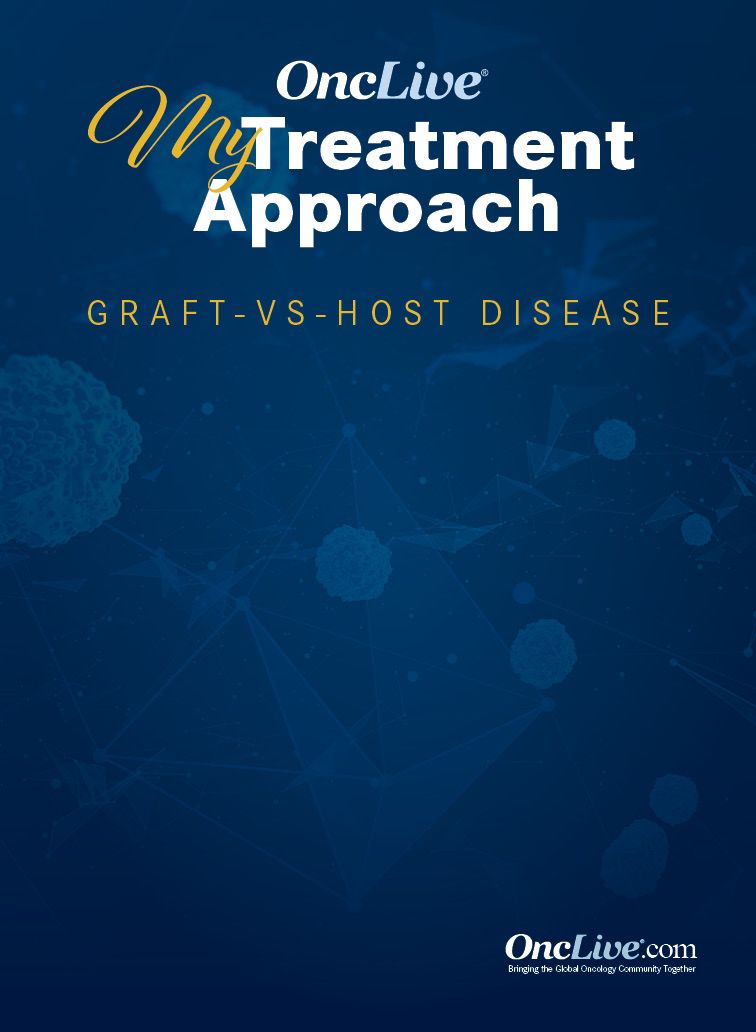Publication
Article
Supplements and Featured Publications
Variable Chronic GVHD Presentations Stress the Need for Close Symptom Monitoring
Author(s):
Joyce L. Neumann, PhD, APRN, AOCN, BMTCN, FAAN, discusses the variability in cGVHD presentation, key symptoms of the disease in patients with cancer, and how the field is navigating between available therapies.
Joyce L. Neumann, PhD, APRN, AOCN, BMTCN, FAAN

The variability in symptomatic indicators of chronic graft-vs-host disease (cGVHD) emphasizes the need to closely monitor patients posttransplant for signs of cGVHD development, said Joyce L. Neumann, PhD, APRN, AOCN, BMTCN, FAAN, adding that the field is continuing to learn how to optimize frontline corticosteroids amid novel, FDA-approved second- and third-line options.
“cGVHD has been sometimes described as an ember where sometimes it flares up and quickly causes a lot of symptoms. Other times, it is this small ember that is there for a period, sometimes years, but we can control it with minimal intervention,” said Neumann, program director of Stem Cell Transplantation and Cellular Therapy at The University of Texas MD Anderson Cancer Center.
“Immunosuppression is always the main stumbling block in terms of controlling GVHD because infections can also be a high-risk factor for morbidity and mortality. We try to minimize [the risk] and manage [the disease] with low-dose immunosuppressant drugs,” Neumann added.
In an interview with OncLive®, Neumann discussed the variability in cGVHD presentation, key symptoms of the disease in patients with cancer, and how the field is navigating between available therapies.
OncLive®: What are some symptomatic indicators that a patient may have developed cGVHD?
Neumann: The changes related to cGVHD that we see are much different than [those seen with] acute GVHD [aGVHD]. Although the skin, liver, and gastrointestinal [GI] tract can be involved [in aGVHD], they tend to be much more subtle at onset [than in cGVHD]. It’s important for clinicians and providers to realize what some of those early signs might be.
Related to skin, instead of the typical erythematous maculopapular rash that we see with aGVHD, [cGVHD can have] changes related to the texture, thickness, or sense of the skin in terms of scleroderma-type changes. It can also be changes to the surface of the skin, such as drop-out of pigment or hyperpigmentation.
Several different changes can occur in the GI tract. [cGVHD can also be characterized by] malabsorption syndrome or, typically for aGVHD, diarrhea or another GI malady.
Almost every organ system can be involved in cGVHD. Sicca syndrome is where there is dryness of the eyes and mouth. Vaginally, there can be dryness as well, in addition to the dryness that some women experience posttransplant with the decrease in estrogen. The lungs can also be affected, so almost every organ in the body can be [affected] by this type of change in the immune system.
Is there a diagnostic tool that can confirm cGVHD or is diagnosis based on clinical symptoms?
There are some diagnostic [tests] that we can do. For example, we may do a skin biopsy or a GI biopsy. Sometimes it is a clinical implication, so that examination is a key. However, we also have pulmonary function tests that are essential for diagnosis of lung GVHD. We also have scanning and imaging that can be helpful in making the diagnosis.
What resources are available to patients to ensure they understand potential symptoms of cGVHD?
It is just the recognition of those changes that can occur, and they can occur over time. It takes knowledge of what to examine for. Patients need to be educated on what some of those signs and symptoms are, and we try to do that before they even leave our transplant center. We also provide them with documents and education for their providers in the community if they don’t live in our area so that their providers can contact and consult our GVHD experts and stem cell transplant physicians.
Is there anything that can be done to minimize the risk of a patient acquiring cGVHD after transplant?
This is where the science has changed over the years, and [we have seen] some important changes. We recognize now that the type of donor we have can affect [the likelihood of a patient developing cGVHD], just like aGVHD and its incidence. All factors related to donor selection, whether it is a haploidentical, cord blood, or matched unrelated with the registry, can minimize [the risk of cGVHD]. Certainly, the prophylactic treatment for GVHD [is a factor]. When do we take patients off [prophylactic treatment]? Unlike a solid or organ transplant patient, our patients [who undergo stem cell transplant] can eventually come off most immunosuppression, which sometimes keeps the GVHD in check.
Recognizing that tapering has to occur rather than abrupt changes [is important]. The recognition of what may appear to be GVHD after those immunosuppressive agents are tapered off [is also critical].
Some of the things that can minimize [the risk of cGVHD] is patient education about healthy living, avoiding sun exposure, and other things that could perhaps set off a GVHD sequelae.
Similar to aGVHD, donor selection is probably the key, as well as what we are using for prophylactic immunosuppression to prevent GVHD.
How have initial therapeutic options changed in cGVHD?
We’ve been very fortunate over the past several years. The gold standard has always been steroids, perhaps on top of immunosuppressive drugs like tacrolimus or sirolimus. However, we all know that steroids produce a lot of different toxicities and problems. We’re fortunate in that there are new agents are now on the market that have come out over the past few years. They have been FDA approved. [The new agents] affect the immune system in a different way to our typical immunosuppressants.
Ibrutinib [Imbruvica] was the first on the market for cGVHD, followed by ruxolitinib [Jakafi]. The newest agent is belumosudil [Rezurock], which is approved for cGVHD. We are looking at those agents in terms of their safety profiles. We participated in some of the initial studies of those drugs, so it is exciting to see other options.
Extracorporeal photopheresis [ECP] has been an option for the treatment of [patients with] cGVHD; however, between a central line placement and [the need to be] close to a center that does ECP, that treatment has been burdensome and expensive for our patients. We are excited by the new agents that are now available.
You highlighted that steroids are associated with their own unique toxicities and burdens. If a patient is experiencing steroid-related toxicities, do you taper the steroids or jump immediately to one of the newer agents, such as ruxolitinib?
Depending upon presentation, we may start to get a quick start on controlling the signs and symptoms of cGVHD by starting the newer agent while using steroids as a bridging agent. Then we taper [the steroids] more quickly than we might have done in the past. As we add the newer agent, we might slowly taper the steroids. Getting patients off steroids is one of the first things that we try to do when we are managing cGVHD, but we don’t usually do anything abruptly because we know patients can flare.
With agents like ibrutinib, ruxolitinib, and belumosudil approved, is there any utility for off-label use of agents like rituximab (Rituxan), for example?
We had been using rituximab in the past with some success. It’s a weekly infusion, usually given 4 times. It is not our first go-to drug because, again, if patients are from out of town, it can be difficult to coordinate intravenous treatment over that 4-week period. However, we have used rituximab.
With ibrutinib and ruxolitinib approved for the same indication, how is the field selecting between the agents?
That’s a good question and it’s been more about the safety profiles. If the patient has low blood counts and the graft is somewhat difficult to control to keep those counts in a normal range, we might go with 1 drug vs the other. Although some of them have the same toxicity profile, we [ask questions like]: How are patients tolerating the drug? Does it cause toxicities like diarrhea or pancytopenia in addition to dropping counts?
[Treatment selection is made on] an individual basis, but as a rule, we are looking to set some standards or guidelines for our patients.
What was observed from the phase 3 REACH2 trial (NCT02913261) regarding the differences in responses by grade with ruxolitinib? What questions remain with ruxolitinib that need to be answered?
The difference has to do with the safety profiles and how the dosing affected some of those adverse effects. Ruxolitinib has been a major benefit for patients, but we are [parsing out] dosing and assistance programs if the patient does not have good coverage for medications. What can we do to help patients manage the expense and financial toxicity of therapies?
What are some ongoing research efforts for cGVHD management?
Newer agents are coming on the market. We are looking at some of those right now with some of the other agents that tend to have a better safety profile. We are always researching this topic and we will continue to look at what our colleagues around the world are finding as it relates to newer therapies.










